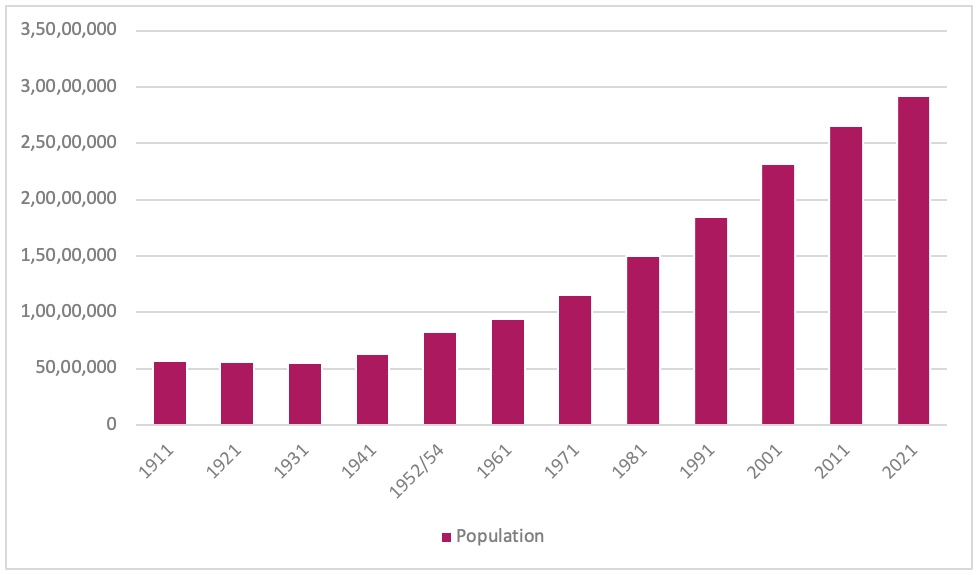Census reports of Nepal are released every 10 years. The Census Report, 2021 is the 12th report since 1911. This report contains the updated demographic data of Nepal which can be used by the federal, state, and local governments to access important information. It’s a preliminary report that presents Nepal’s population data and its trends. The detailed final report is still awaited.
Overview
According to the Census Report 2021, the population of Nepal has reached 29,192,480, which is an increase of 2,697,976 compared to a population of 26,494,504 ten years ago. Since 2011, Nepal’s population has grown by 10.18%. However, the average annual growth rate is 0.93%, a decrease from the data reported in the Census Report of 2001-2011, which presented a growth rate of 1.35%. The decrease in the population growth, the lowest in 80 years, is the result of several factors including decreasing fertility rate, increasing migration, public health, and urbanization. The fertility rate in Nepal has declined over the years, from 2.516 in 2011 to 1.853 in 2021. Additionally, the decision of families to have fewer children with the average family size being 4.33 compared to 4.88 from the last report, due to increasing living costs and employment of parents is believed to have contributed to this decline.
Figure 1. Nepal population over the years (Millions)

Source: Census Nepal Report, 2021; Central Bureau of Statistics
According to the report, the total population is 14,291,311 males (49%) and 14,901,169 females (51%). The sex ratio for males per 100 females is 95.91, slightly higher than 94.16 from the last census demonstrating a slight increase in the male population. While there are more females in the total population, a slight increase in the population of males since 2011 has been observed.
To analyze the declining population growth, the article will delve deeper into the key areas presented in the report of 2021, including migration, urbanization, and declining rural population.
Increase in Migration
A total of 2,169,478 Nepali persons are living abroad, an increase from 1,921,494 in 2011. Among them, 1,684,029 are males while 237,400 are females. Since 2011, more and more Nepalis have migrated abroad in search of better opportunities which in turn is a critical factor for the lower population growth rate in Nepal, presented in the recent census report of 2021. Despite the pandemic, more than 240,000 labor permits were granted in 2021 alone, which does not include workers moving to India. Due to this, around 30% of Nepal’s GDP is in the form of remittance. The census report also highlighted that the number of women that migrated to foreign countries has increased by 71% in comparison to the previous census owing to the development of information and technology.
Growing urban population
Evidently, Kathmandu Metropolitan City has the highest population of 8,45,767 and the highest population density of 5,108 persons per square kilometer. The rapid growth in population has led to mismanaged urbanization as more people are migrating to cities like Kathmandu, Bhaktapur and Butwal making it more populous.
In 2021, the urban population reached 66.8%, which is an increase from what was reported in the 2011 report, where urban population was at 63.2%. In contrast to this, the rural population has decreased to 33.9% in 2021 in comparison to a 36.8% in 2011. Increase in poverty, a lack of education, and employment opportunities in rural areas are key motivators for people to relocate from rural to urban areas. As more people migrate to urban areas in search of employment, income levels tend to rise as more jobs and opportunities are available due to the economic activity.
As cities get more populous, policies are needed to develop urban infrastructure and provide access to essential services including health care, schooling, sanitation, and a waste management system for the urban poor.
Declining rural population
The out-migration from 32 districts, including Ramechhap (-1.65% population growth), Khotang (-1.56 %), Manang (-1.41 %), and Bhojpur (-1.32 %) played a big role in the decline of rural population. Subsequently, a population growth of districts like Bhaktapur (3.32%), Rupandehi (2.3 %), and Chitwan (2.3 %) with new urban centers like Bharatpur and Butwal, has been observed. According to the report, 53.66 % of the population lives in the Terai, 40.25 % in the hilly region, and 6.09 % in the mountain region. More people are moving from the mountains to Terai owing to the development of cities in the Terai region. Similarly, Terai’s population density is rising quickly, reaching 461 people/sq km, compared to only 34 people/sq km in the mountains. For instance, the Madhesh Province is getting populous with 21% of the population now living there.
Rural areas in Nepal continue to be disadvantaged in terms of access to basic health services and opportunities for education and employment. Along with cities, rural development is important to alleviate poverty, control mass out-migration, create jobs, maintain the population, and reduce disparities. Developing rural infrastructure, building schools, hospitals, or health posts, and generating employment would need to be put into action in order to address the issues of urbanization.
Conclusion
Although the population has risen by 10.18% since the last census report, the annual growth has been at it 80 years lowest at 0.93%. Increasing migration, urbanization and decreasing fertility are major factors in the slow population growth. As a Least Developed Country (LDC), it is important for Nepal to maintain its population to prevent a rapid rise which will negatively impact economic development. While the report is at its preliminary stage, the final report will present extensive data on other patterns and trends which is yet to be released.
Adhrit Shrestha is a B.A. Graduate from Beloit College, USA, with a major in Business Economics and a minor in Political Science. His key interests lie in investment management, private equity, strategy consulting and entrepreneurship. Prior to joining beed, Adhrit worked in tech companies in analyst roles. He is currently working as a beed Fellow at beed Management.





